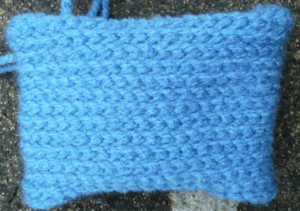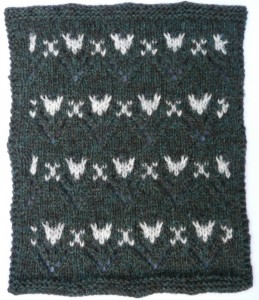I have just finished reading Knitting in the Old Way: Designs and Techniques from Ethnic Sweaters by Priscilla Gibson-Roberts and Deborah Robson (a very interesting read by the way). The last chapter is on combining crochet with knitting, and they talk about the differences between Eastern and Western crochet. Basically with Western crochet you poke your hook through both legs of the chain of the stitch, whereas with Eastern crochet you only use one leg of the chain. So there are two different kinds of Eastern crochet, the version where you use the front leg of the chain, and the version where you use the back leg. The front leg version is also known as Shepherd’s knitting, and the back leg version is also known as Bosnian crochet. After reading the description of Shepherd’s knitting I was fascinated by how it would come out so I had a go.
I worked a length of chain, joined it into a circle, and then worked a slip stitch into the front leg of each chain as I went round. Carry on until you have had enough.
Here is the side which forms away from you as you are working.
And here is the side which forms towards you as you are working.
It looks a lot like knitting, but on its side.
It was quite fun to do, though I am a rather slow crocheter. The finished fabric is not as elastic as knitting, and it does have a bit of a tendancy to bias. I think you could make really interesting things with using bands of this separating sections of knitting. Definitely something to play a bit more with.






























